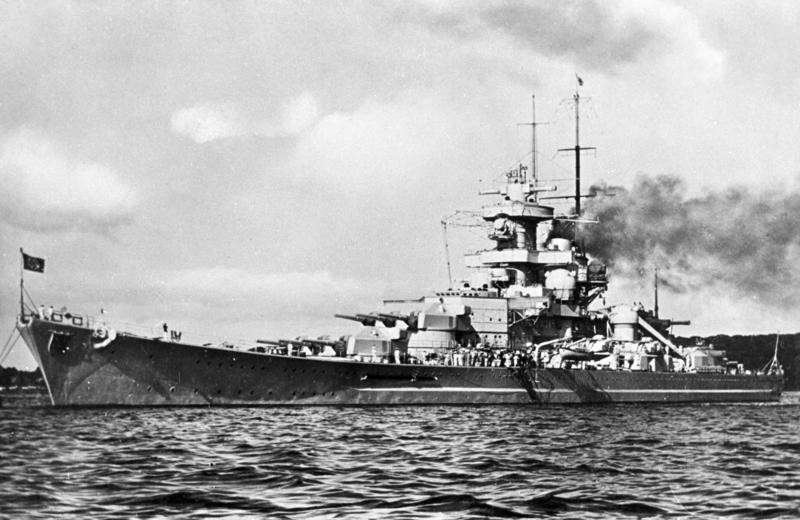The Gneisenau was a German battleship that served as a key instrument in World War II naval operations, undertaking notable missions like Operation Berlin and Operation Cerberus.

Commissioned in 1938, she was a symbol of the re-emergence of German naval power.
Despite her eventual decommissioning and scuttling, her strategic and tactical impact, combined with her embodiment of a critical period in naval engineering and warfare, leaves a lasting legacy.
Design
The Gneisenau, named after August Neidhardt von Gneisenau, a prominent Prussian military reformer, was part of the Scharnhorst class, consisting of two German capital ships, the first built by the Kriegsmarine after World War I.
The sister ship to Gneisenau was the Scharnhorst, and the construction of both was a clear violation of the Treaty of Versailles, which aimed to restrict Germany’s military capability.
The Gneisenau was laid down at the Germaniawerft shipyard in Kiel in May 1935. Germaniawerft was a prestigious shipyard, famous for constructing U-boats during both World Wars.
The battleship’s keel laying marked a pivotal moment in the resurgence of Germany’s naval power under Adolf Hitler.
Gneisenau’s hull was launched in December 1936, marking the beginning of the complex fitting-out process. This involved installing the engines, boilers, weapons systems, and other equipment necessary for a warship of her size and purpose.
One of the innovative design features of Gneisenau was her “Atlantic bow,” a marked departure from the older “clipper bow” design.
 Gneisenau pictured in 1939. Image by Bundesarchiv CC BY-SA 3.0
Gneisenau pictured in 1939. Image by Bundesarchiv CC BY-SA 3.0
The Atlantic bow was more pointed and extended, which offered better seakeeping ability and more deck space for forward gun turrets.
This innovation made Gneisenau and her sister ship, Scharnhorst, better equipped to handle the rough seas of the North Atlantic.
The Gneisenau was powered by a robust propulsion system consisting of three Brown, Boveri & Co turbines and twelve ultra-high-pressure boilers. This allowed the warship to reach a top speed of 31.5 knots, which was impressive for a battleship of her size.
From a defensive standpoint, Gneisenau was equipped with substantial armor protection. She had a belt armor thickness of 350mm and deck armor of up to 105mm, designed to protect the ship’s vital areas against incoming enemy fire.
On the offensive front, Gneisenau was equipped with nine 28 cm (11 in) SK C/34 guns, housed in three triple turrets.
The choice of 28cm guns was due to treaty restrictions and proved less powerful than the 35.6 cm (14 in) guns deployed on most comparable Allied battleships.

Gneisenau’s forward two 28 cm triple turrets. The ship to the left is her sister ship – the Scharnhorst. Image by Naval History and Heritage Command
However, the Gneisenau’s guns still packed a formidable punch and were quite capable in a variety of combat scenarios.
Later in her career, plans were made to replace these guns with six 38 cm (15 in) SK C/34 guns in twin turrets, but the upgrades never came to fruition due to ongoing disruptions caused by wartime bombings and a shortage of resources.
The Gneisenau was commissioned in May 1938, marking her readiness for active service.
Operational History Of Gneisenau
Commissioned in May 1938, the Gneisenau and her sister ship, the Scharnhorst, swiftly became the mainstay of the German Navy’s operational strategy during the Second World War.
Their missions exemplify Germany’s approach to naval warfare, demonstrating a balance of aggressive tactics and careful strategy that leveraged the battleships’ superior speed, maneuverability, and firepower.
The operational life of Gneisenau was initiated with a series of North Atlantic patrols intended to strengthen Germany’s presence in these critical shipping lanes.
The Gneisenau’s main objective during these patrols was to disrupt and destroy Allied merchant shipping, thereby severing the lifelines that kept Britain supplied with the necessary resources to continue the war effort.
The most significant operation involving Gneisenau was Operation Berlin, which unfolded between January and March 1941.
Under the command of Admiral Günther Lütjens, Gneisenau, and Scharnhorst embarked on a commerce raiding mission in the North Atlantic.
 Gneisenau pictured in 1938. Image by Bundesarchiv CC BY-SA 3.0
Gneisenau pictured in 1938. Image by Bundesarchiv CC BY-SA 3.0
It was during this operation that the battleships truly displayed their predatory prowess. By the time Operation Berlin concluded, the two battleships had sunk 22 Allied merchant vessels, totaling approximately 116,000 gross register tons (GRT).
The operation had severe repercussions for the Allies, causing significant disruptions in supply lines and inspiring fear among the convoys.
However, it was Operation Cerberus, also known as the “Channel Dash,” that arguably cemented the reputation of Gneisenau as a formidable adversary. In February 1942, Gneisenau, Scharnhorst, and the heavy cruiser Prinz Eugen undertook an audacious daylight passage through the heavily defended English Channel from Brest in France to Germany.
This high-risk maneuver was necessitated by the need to avoid the increasingly effective British naval blockade and to return the warships to home waters for necessary repairs and refits.
Despite being detected by British radar and pursued by the Royal Navy and RAF, the German squadron, under the overall command of Admiral Otto Ciliax, successfully made the journey, reaching German waters with minimal damage.
This episode was a major propaganda coup for Germany and a corresponding embarrassment for the British, who were criticized for failing to intercept the squadron despite having superior forces in the area.
Fate Of Gneisenau
While Gneisenau was instrumental in various successful naval operations, she was not immune to the dangers of warfare.
During her service, she encountered numerous combat situations and adverse conditions, which inevitably led to substantial damage.
The most significant damage occurred during an air raid by the British Royal Air Force on Kiel in late February 1942. An armor-piercing bomb struck the Gneisenau, detonating on impact and causing severe damage to her forward turret.
The destruction was so significant that it required extensive repairs, thereby taking Gneisenau out of operational service indefinitely.
As attempts were made to repair Gneisenau, she was further damaged by additional air raids.
The ongoing attacks and sustained damage to the ship led to a reassessment of her strategic value by the German high command.
In light of the increasingly perilous situation, the decision was made in 1943 to decommission Gneisenau.
 Two Handley Page Halifaxes fly towards the drydock where the Gneisenau and Scharnhorst are berthed during a daylight raid.
Two Handley Page Halifaxes fly towards the drydock where the Gneisenau and Scharnhorst are berthed during a daylight raid.
Her main armaments were removed and repurposed as shore batteries on the German-occupied coastlines, serving as a critical component of the Atlantic Wall fortifications.
The original plan to convert Gneisenau into an aircraft carrier, codenamed “Project Jade,” was considered but ultimately abandoned due to the scarcity of resources and the changing dynamics of the war.
With the ship stripped of her main armaments and left unrepairable, Gneisenau’s fate was sealed.
In March 1945, the battleship was scuttled in Gotenhafen (present-day Gdynia, Poland) in the face of the advancing Soviet Army to prevent her from falling into enemy hands.
She was partially broken up in situ after the war, and the remains were ultimately demolished in the late 1940s and early 1950s.
Legacy
Gneisenau represents a distinct era in naval engineering.
Her design embodied the progress in shipbuilding technology during the interwar period.
Although her main guns were smaller than those of contemporary battleships, her high speed, armor protection, and operational range made her a significant threat to Allied navies and merchant marine alike.
Moreover, Gneisenau’s story reflects the ambition of Nazi Germany’s naval expansion, symbolizing the country’s defiance against the Treaty of Versailles.
Her construction and deployment marked the re-emergence of German naval power, which held profound implications for the geopolitical landscape of the time.
The legacy of Gneisenau transcends her physical existence. She embodies the intricacies of naval strategy, the power of maritime engineering, and the ebbs and flows of geopolitical tension.
Despite her eventual fate, her impact on naval warfare and her contribution to the study of maritime strategies endures.
Through her history, future generations can understand and appreciate the significant role played by naval forces in the theater of global conflict.
News
A Creative Journey: Lady Gaga’s Artistic Growth and Fearless Embrace of Individuality
The weirdness and craziness of star Lady Gaga’s outfits have been increasing every day. Even if she were dressed in rags and beggar clothes, no one would be surprised. Lady Gaga created her own unique, shocking fashion line that no…
Gaga’s Street Style: No Bras, Semi-Sheer Top, and Daring Daisy Dukes in NYC
Lady Gaga recently unveiled the much-anticipated track list for her latest album, Joanne, and she is certainly not shying away from the limelight. The singer was spotted in New York on Saturday confidently flaunting her unique fashion sense. Her daring…
VIDEO : Unexpected Flashback: Old Footage Resurfaces Showing Lady Gaga’s Unusual On-Stage Act with a Girl Vomiting on Her Chest
It’s come back up. A clip of a woman making herself vomit on Lady Gaga during her SXSW performance in 2014 has resurfaced online — and the bile hasn’t aged well. Gaga, 36, incorporated performance artist Millie Brown into her choreography…
My First Piano Teacher Was a Stripper’: Lady Gaga Reveals Dad Hired a Stripper as Her Music Teacher, Linking it to Her Signature Long Nails
Lady Gaga is one of the popular artists who’s known for image reinventions and musical versatility. She rose to fame with her debut studio album, The Fame in 2007 with its chart-topping singles Just Dance and Poker Face. She is not only…
20 Bizarre Photos Prove That Lady Gaga Is The Most Unhinged Fashion Icon Ever
One of the most iconic and multi-talented artists of our time, Lady Gaga, with worldwide hits such as Bad Romance, Judas, and Born This Way, is also known as a composer, an actress, and above all, a fashionista. Known as…
Lady Gaga Goes Makeup-Free for Oscars Performance, Letting People See the Real Her
Oscars executive producer reveals Lady Gaga decided to go makeup-free during her performance to show people the ‘real’ her. Featured Image Credit: ABC Yesterday (March 13), the musician stunned viewers with a performance of the Oscar-nominated song ‘Hold My Hand’…
End of content
No more pages to load











